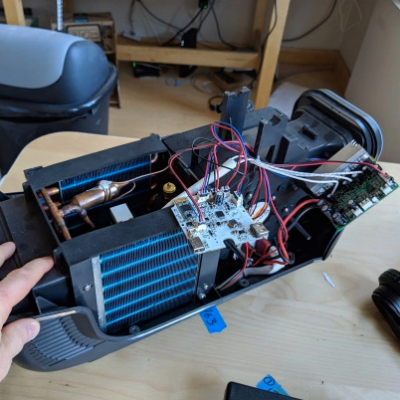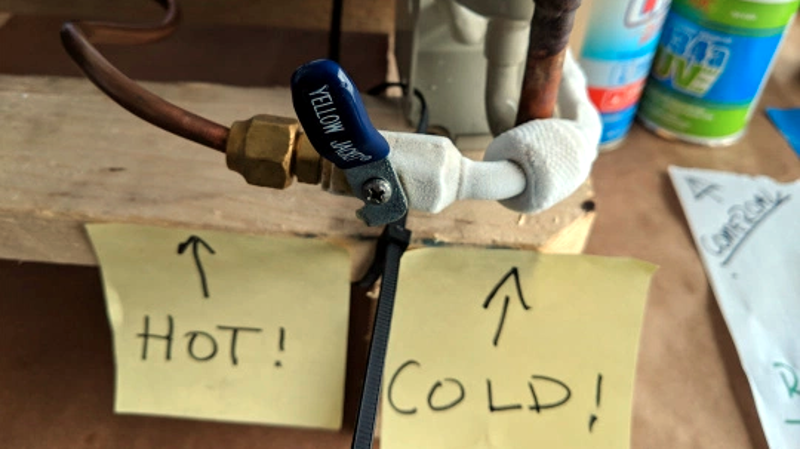Air conditioners are easy to take for granted. From refrigerators to climate control, most of us would miss them dearly if they disappeared. That’s part of what draws [Josh Levine]’s interest in air conditioners, and he has provided an interesting tour of several different units and how different they can be, despite all working in basically the same way.

One way that air conditioners try to stand out is by being quiet, and the bulk of noise comes from the fans and the compressor. One unit (the Haier Serenity) aimed to be the quietest unit possible, but while this effort had mixed results at best it is still interesting to see [Josh] give a tour of the different ways they tried to reduce noise (YouTube, embedded below). Noise-limiting elements include the unusual step of using separate motors for the indoor and outdoor fans, and even little counterweights to ensure they are perfectly balanced, just like wheel weights on automobile tires.
Another notable air conditioner is the Zero Breeze, a portable unit that was the product of a Kickstarter campaign. Features included (either bizarrely or predictably, you be the judge) a bluetooth speaker and an LED flashlight. [Josh] more than half suspected the product would never actually ship, but was pleasantly surprised. Not only did it deliver, it turned out to be a pretty nice design with only a couple of mildly head scratching moments (YouTube, also embedded below).
There are a few more to check out in the roundup on [Josh]’s web site, which he also compares and contrasts with his own DIY unit which we featured in the past.
















Anything using sound to cool?
I’ve not seen any. Some use evaporative cooling but they tend to be a fabric that absorbs water.
I guess you could use one of these piezoelectric misters from fog baths or electric air freshners but I can’t imagine it being terribly efficient in comparison with passive cooling and a fan. I guess you could make some sort of acoustic heat pump like a helium cryocooler but that might be a bit overkill. (:
Google refrigeration with sound waves
and find out
Interesting overview. Ever since investing in the Dometic Fridge/Freezer that runs on 120VAC or 12-14VDC… I’ve been more interested in studying how the different designs work. Coupled with the younger years wanting to make a solar old school ammonia (maybe improved modern version) and wondering how the motor home’s electric and more-so gas powered fridge/freezer worked. Like… heat to make less heat?
Amazing how much more efficient these are getting too:
https://www.dometic.com/en-us/us/products/food-and-beverage/coolers/electric-coolers/dometic-cfx-65w-_-152179
Surprised more haven’t overclocked their motherboards using dehumidifiers, AC’s or even these newer more efficient DC units.
Reminds me also of the NSA data center warehouse out in Utah that wastes like a million gallons of water a day or something like that where they can save the freshwater and just use cryocooling units that are solar/wind powered. Even if they just recycled the water they use to pump the heat out with cooling towers or other heat exchange designs. Almost seems like the NSA is intentionally wasting the water as a not public service.
I’m surprised they allow the cooling water out of their sight without burning it first, to ensure that there’s no risk of data being leaked through it…
Any homeopath could tell you that the water retains the memory of the ones and zeroes.
By letter the cooling water mix with water in the drain, the entropy is increased, and it is harder for an adversary’s homeopath to ex-filtrate the ones and zeros… that is, until quantum homeopathic supremacy is achieved.
I’m just. Yeah.
Typo: 14V = 24V.
@Dan & @e, et.al.: I won’t add any “salt” to the situation.
No matter what chemical is being used. It’s all about the pressure you put it under and the physical change that takes place when it depressurizes.
The split will most likely be to compensate for the fact the gas warms up too fast. So two short lengths mean it’s cold for the whole length of both and not just the first half of one long length.
Some come with a leaf switch for detection of the water trap and most seem a little fickle about start up and shutdown. Presumably to protect the pump. They can be pretty useful to keep things cold / hot. I keep meaning to try and cool a CPU with one at some point.
On a side note;
The fine is pretty big if you let these leak and get caught. Plus the gases used can be pretty nasty on some of the older models and usually pretty flammable.
it is usually modern refrigerants like butane that are flammable
Are there any domestic water-chillers, so you can hook up multiple different kinds of fan-coil etc units?
Or is it possible to convert an aircon to a water chiller?
Also, for inverter aircons, it should be possible to power them directly with DC by bypassing the rectifyer, rather than springing for an expensive “off-grid solar DC” model. What internal voltage do they generally run on?
A heat pump pool heater is probably the closest thing if you can reverse the refrigerant flow. Inverter air conditioners will run from DC but the DC bus is usually SQRT(2) times your mains voltage (340v in Aus). Inverter compressors will also happily run from a standard VFD which is easily controlled by anything that can use RS232/485. Just don’t run the compressor backwards, I attempted to convert an inverter air conditioner to a water chiller to freeze 1000L of water (which is something like 100KWh of thermal storage i.e. many days of air conditioning) but stupidly set the VFD to backwards once and killed the project in seconds.
Since you asked, the capillary tubing needs to be a specific length to accommodate the amount of refrigerant required for proper heat transfer. you can see an explanation here: http://www.jbind.com/pdf/TC-803-308%20Cap%20Tube%20Manual.pdf
So they just loop it around because the engineer had to work with a specific id of tubing and that resulted in a very precise length of tubing. each run would handle roughly 1/2 of the total btuh of the unit.
There’s a hybrid solar/mains unit available from manufacturer “Gree”.
It needs about 1kW of solar to run – approx four panels – and it will run the compressor entirely on solar until input drops too low in the mid-late afternoon, then it switches to mains.
Don’t know whether the internal voltage is DC or AC – inverter to convert DC to AC, or rectifier to convert AC to DC
Note the polystyrene on the Hair unit between the evaporator (cool side) and compressor area. Not having the shaft from the outside fan penetrate through that keeps a lot of the sound from traveling through, polystyrene being an insulator as well, so the compressor doesn’t need to be fully insulated. A bit more insulation on the compressor wouldn’t have hurt, but I’m sure the bean counters weighed cost of material, time for install, and effectiveness for how much to actually put in.